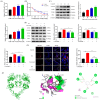Gallic Acid Can Promote Low-Density Lipoprotein Uptake in HepG2 Cells via Increasing Low-Density Lipoprotein Receptor Accumulation
- PMID: 38731489
- PMCID: PMC11085419
- DOI: 10.3390/molecules29091999
Gallic Acid Can Promote Low-Density Lipoprotein Uptake in HepG2 Cells via Increasing Low-Density Lipoprotein Receptor Accumulation
Abstract
Gallic acid (GA) is a type of polyphenolic compound that can be found in a range of fruits, vegetables, and tea. Although it has been confirmed it improves non-alcoholic fatty liver disease (NAFLD), it is still unknown whether GA can improve the occurrence of NAFLD by increasing the low-density lipoprotein receptor (LDLR) accumulation and alleviating cholesterol metabolism disorders. Therefore, the present study explored the effect of GA on LDLR and its mechanism of action. The findings indicated that the increase in LDLR accumulation in HepG2 cells induced by GA was associated with the stimulation of the epidermal growth factor receptor-extracellular regulated protein kinase (EGFR-ERK1/2) signaling pathway. When the pathway was inhibited by EGFR mab cetuximab, it was observed that the activation of the EGFR-ERK1/2 signaling pathway induced by GA was also blocked. At the same time, the accumulation of LDLR protein and the uptake of LDL were also suppressed. Additionally, GA can also promote the accumulation of forkhead box O3 (FOXO3) and suppress the accumulation of hepatocyte nuclear factor-1α (HNF1α), leading to the inhibition of proprotein convertase subtilisin/kexin 9 (PCSK9) mRNA expression and protein accumulation. This ultimately results in increased LDLR protein accumulation and enhanced uptake of LDL in cells. In summary, the present study revealed the potential mechanism of GA's role in ameliorating NAFLD, with a view of providing a theoretical basis for the dietary supplementation of GA.
Keywords: LDLR; NAFLD; PCSK9; cholesterol metabolism; gallic acid.
Conflict of interest statement
The authors declare that they have no known competing financial interests or personal relationships that could have appeared to influence the work reported in this paper.
Figures





Similar articles
-
Enhanced pro-protein convertase subtilisin/kexin type 9 expression by C-reactive protein through p38MAPK-HNF1α pathway in HepG2 cells.J Cell Mol Med. 2016 Dec;20(12):2374-2383. doi: 10.1111/jcmm.12931. Epub 2016 Sep 15. J Cell Mol Med. 2016. PMID: 27633999 Free PMC article.
-
Ascorbic acid enhances low-density lipoprotein receptor expression by suppressing proprotein convertase subtilisin/kexin 9 expression.J Biol Chem. 2020 Nov 20;295(47):15870-15882. doi: 10.1074/jbc.RA120.015623. Epub 2020 Sep 10. J Biol Chem. 2020. PMID: 32913121 Free PMC article.
-
Ellagic acid ameliorates atherosclerosis by inhibiting PCSK9 through the modulation of FoxO3 and HNF1α.Nutrition. 2025 Jun;134:112717. doi: 10.1016/j.nut.2025.112717. Epub 2025 Feb 18. Nutrition. 2025. PMID: 40086009
-
Targeting the proprotein convertase subtilisin/kexin type 9 for the treatment of dyslipidemia and atherosclerosis.J Am Coll Cardiol. 2013 Oct 15;62(16):1401-8. doi: 10.1016/j.jacc.2013.07.056. Epub 2013 Aug 21. J Am Coll Cardiol. 2013. PMID: 23973703 Review.
-
[PCSK9: Structure and function. PCSK9 and low-density lipoprotein receptor. Mutations and their effects].Clin Investig Arterioscler. 2016 May;28 Suppl 2:3-8. doi: 10.1016/S0214-9168(16)30164-4. Clin Investig Arterioscler. 2016. PMID: 27888903 Review. Spanish.
Cited by
-
Regulatory mechanisms of hepatocyte PCSK9 expression: translating mechanistic insights into potential nutraceuticals.Chin Med. 2025 Aug 5;20(1):121. doi: 10.1186/s13020-025-01178-y. Chin Med. 2025. PMID: 40764605 Free PMC article. Review.
-
Metabolic-Associated Fatty Liver Disease: The Influence of Oxidative Stress, Inflammation, Mitochondrial Dysfunctions, and the Role of Polyphenols.Pharmaceuticals (Basel). 2024 Oct 10;17(10):1354. doi: 10.3390/ph17101354. Pharmaceuticals (Basel). 2024. PMID: 39458995 Free PMC article. Review.
-
Based on Network Pharmacology and Molecular Docking, the Active Components, Targets, and Mechanisms of Flemingia philippinensis in Improving Inflammation Were Excavated.Nutrients. 2024 Jun 13;16(12):1850. doi: 10.3390/nu16121850. Nutrients. 2024. PMID: 38931205 Free PMC article.
-
Gallic acid: a dietary metabolite's therapeutic potential in the management of atherosclerotic cardiovascular disease.Front Pharmacol. 2025 Jan 7;15:1515172. doi: 10.3389/fphar.2024.1515172. eCollection 2024. Front Pharmacol. 2025. PMID: 39840111 Free PMC article. Review.
-
Chlorogenic acid targets SIRT6 to relieve UVB - induced UV damage.Arch Dermatol Res. 2025 Mar 19;317(1):600. doi: 10.1007/s00403-025-04134-w. Arch Dermatol Res. 2025. PMID: 40105999
References
-
- He Y., Rodrigues R.M., Wang X., Seo W., Ma J., Hwang S., Fu Y., Trojnar E., Matyas C., Zhao S., et al. Neutrophil-to-hepatocyte communication via LDLR-dependent miR-223-enriched extracellular vesicle transfer ameliorates nonalcoholic steatohepatitis. J. Clin. Investig. 2021;131:e141513. doi: 10.1172/JCI141513. - DOI - PMC - PubMed
-
- Pouwels S., Sakran N., Graham Y., Leal A., Pintar T., Yang W., Kassir R., Singhal R., Mahawar K., Ramnarain D. Non-alcoholic fatty liver disease (NAFLD): A review of pathophysiology, clinical management and effects of weight loss. BMC Endocr. Disord. 2022;22:63. doi: 10.1186/s12902-022-00980-1. - DOI - PMC - PubMed
-
- Li Y.H., Hou J. Research progress in the regulation of cholesterol metabolism and its involvement in the occurrence and development of liver cancer. Chin. J. Cancer Biother. 2021;28:1215–1218.
-
- Zhang Q., Xu C., Tang Z.K. Regulation Mechanism of Intracellular Cholesterol Level. Prog. Biochem. BioPhys. 2022;49:292–302.
MeSH terms
Substances
Grants and funding
LinkOut - more resources
Full Text Sources
Research Materials
Miscellaneous

